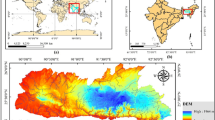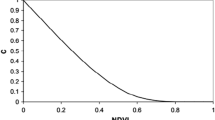Abstract
Purpose
Shallow soils previously cultivated under terraced systems may change their properties after agricultural release and spontaneous plant colonization. Investigations were conducted in terraced fields (NE Spain) to prove that vegetation installed after the abandonment may generally improve soil properties by the formation of stable organic horizons. However, restriction in plant species along the natural vegetation succession and intensification of erosion processes may occur after abandonment depending on fire frequency and soil use history.
Materials and methods
Ten environments with different plant covers under a Lithic Xerorthent were selected and erosion plots (Gerlach type) installed providing their best adaptability at the terrace scale. Selected soil environments represented the sequence of abandonment: from current poorly cultivated soils, soils under pasture, soils under shrubs, and soils under stands of pine and cork trees. Relevant rainfall events producing runoff and erosion were recorded from November 2011 to May 2012. Erosion rates and erosion components were analysed in sediments and water in order to monitor carbon, nitrogen and other nutrient removal by overland flow. Similarly, the physical and chemical properties of the soil environments under study were determined at the same time interval of runoff erosion.
Results and discussion
Soils under pasture, vines and recently burnt pine forest produced the highest runoff followed by soils under shrubs and forest. However, eroded soil yields and nutrient removal were much higher in cultivated soils and soils in recently burnt sites, which had shown poorer soil properties with respect to soils abandoned for longer and preserved by fire. Fire-affected soil environments also showed a thinner organic horizon and reduced water retention. Although erosion rates and nutrient depletion were low in all environments with respect to other areas of Spain, higher splash than water erosion was an early warning indicator of the high susceptibility to degradation of these shallow soils.
Conclusions
Results outlined that the renaturalization dynamics after agricultural abandonment are complex biophysical processes involving the parent material, depth to bedrock and other soil properties as well as the succession of vegetative cover and plant associations responsible for building a new soil mantle contrasting with erosion processes. Planning for management of land abandonment is strongly recommended.








Similar content being viewed by others
References
Abril A, Barttfeld P, Bucher EH (2005) The effect of fire and overgrazing on soil carbon balance in the dry Chaco forest. Forest Ecol Manag 206:399–405
Albaladejo J, Chisci G, Gabriels D, Rubio JL, Stocking MA (1988) Soil degradation and its impact on desertification: a research design for Mediterranean environments. Soil Technol 1:169–174
Bochet E, Rubio JL, Poesen J (1998) Relative efficiency of three representative matorral species in reducing water erosion at the microscale in a semi-arid climate (Valencia, Spain). Geomorphology 23:139–150
Bremner JM, Mulvaney CS (1987) Nitrogen-Total. In: Page AL, Miller RH, Keeney DR (eds) Methods of soil analysis. American Society of Agronomy Inc and Soil Science Society of America Inc Publisher, Madison, Wisconsin, pp. 595–623
Caroll C, Merton L, Burger P (2000) Impact of vegetative cover and slope on runoff, erosion and water quality for field plots on a range of soils and spoil materials on Central Queensland coal mines. Austr J Soil Res 38:313–327
Celik I (2005) Land-use effects on organic matter and physical properties of soil in a southern Mediterranean highland of Turkey. Soil Till Res 83:270–277
Certini G (2005) Effects of fire on properties of forest soils: a review. Oecologia 143:1–10
De Nobili M, Maggioni A (1993) Influenza della sostanza organica sulle proprietà fisiche del suolo. In: Nannipieri P (ed) Ciclo della sostanza organic del suolo Patron Editore, Bologna, Italy, pp. 43–54
Dunjo G, Pardini G, Gispert M (2003) Land use change effects on abandoned terraced soils in a Mediterranean catchment. Catena 52:23–37
Emran M, Gispert M, Pardini G (2012) Comparing measurements methods of carbon dioxide fluxes in a soil sequence under land use and cover change in north eastern Spain. Geoderma 170:176–185
Flinn KM, Vellend M (2005) Recovery of forest plant communities in post-agricultural landscapes. Front Ecol Environ 3:243–250
Forster J (1995) Soil sampling, handling, storage and analysis. In: Alef K, Nannipieri P (eds) Methods in soil microbiology and biochemistry. Academic Press, London, pp. 49–122
Gerlach T (1967) Hillslope throughs for measuring sediment movement. Rev Geol Dyn Geogr 4:173–175
Gillman GP (1979) A proposed method for the measurement of exchange properties of highly weathered soils. Austr J Soil Res 17:67–77
Gispert M, Emran M, Pardini G, Doni S, Ceccanti B (2013) The impact of land management and abandonment on soil enzymatic activity, glomalin content and aggregate stability. Geoderma 202–203:51–61
Jackson RB, Banner JL, Jobbágy EG, Pockman WT, Wall DH (2002) Ecosystem carbon loss with woody plant invasion of grasslands. Nature 418:623–626
Kemper WD, Rosenau RC (1986) Aggregate stability and size distribution. In: Klute A (ed) Methods of soil analysis, Madison, Wisconsin, SSSA, pp. 425–441
Kosmas C, Gerontidis S, Marathianou M (2000) The effect of land use change on soils and vegetation over various lithological formations on Lesvos (Greece). Catena 40:51–68
Lal R (2003) Soil erosion and the global carbon budget. Environ Int 29:437–450
Lal R (2005) Soil erosion and carbon dynamics. Soil Till Res 81:137–142
Lasanta T, Garcia-Ruiz JM, Pérez-Rontomé C, Sancho-Marcén C (2000) Runoff and sediment yield in a semi-arid environment: the effect of land management after farmland abandonment. Catena 38:265–278
Lesschen JP, Kok K, Verburg PH, Cammeraat LH (2007) Identification of vulnerable areas for gully erosion under different scenarios of land abandonment in Southeast Spain. CATENA 71(1):110–121
Mataix-Solera J, Doerr SH (2004) Hydrophobicity and aggregate stability in calcareous topsoils from fire-affected pine forests in southeastern Spain. Geoderma 118:77–88
Mataix-Solera J, Cerdà A, Arcenegui V, Jordàn A, Zavala AM (2011) Fire effects on soil aggregation: a review. Earth-Sci Rev 109:44–60
Noble AD, Zenneck I, Randall PJ (1996) Leaf litter ash alkalinity and neutralisation of soil acidity. Plant Soil 179:293–302
Olsen SR, Sommers LE (1987) Phosphorus. In: Page AL, Miller RH, Keeney DR (eds) Methods of soil analysis. American Society of Agronomy Inc, Soil Science Society of America Inc Publishers, Madison, pp. 421–422
Pardini G, Gispert M (2006) Impact of land abandonment on water erosion in soils of the eastern Iberian peninsula. Agrochimica 50:13–24
Pardini G, Aringhieri R, Plana F, Gallart F (1991) Soil properties relevant to land degradation in abandoned sloping fields in Aisa Valley, central Pyrenees (Spain). Pirineos 137:79–93
Pardini G, Gispert M, Dunjó G (2003) Runoff erosion and nutrient depletion in five Mediterranean soils of NE Spain under different land use. Sci Total Environ 309:213–224
Pardini G, Gispert M, Dunjó G (2004a) Distribution patterns of soil properties in a rural Mediterranean area in North-Eastern Spain. Mt Res Develop 24:44–51
Pardini G, Gispert M, Dunjó G (2004b) Relative influence of wildfire on soil properties and erosion processes in different Mediterranean environments in NE Spain. Sci Total Environ 328:237–246
Puigdefabregas J (1995) Desertification: stress beyond resilience, exploring a unifying process structure. Ambio 24:311–313
Saa A, Trasar-Cepeda MC, Gil-Sotres F, Carballas T (1993) Changes in soil phosphorus and acid phosphatase activity immediately following forest fires. Soil Biol Biochem 25:1223–1230
Scarascia-Mugnozza G, Oswald H, Piussi P, Radoglou K (2000) Forests of the Mediterranean region: gaps in knowledge and research needs. Forest Ecol Manag 132:97–109
Soil Survey Staff (SSS) (2010) Keys to soil taxonomy. SMSS Technical Monograph Pocahontas Press Inc, Blacksburg, Virginia
Swaine M (1996) Rainfall and soil fertility as factors limiting Forest species distributions in Ghana. J Ecol 84:419–428
Trabaud L, Oustric J (1989) Heat requirement for seed germination of three Cistus species in the garrigue of southern France. Flora 183:321–325
Vance ED, Brookes PC, Jenkinson DS (1987) An extraction method for measuring microbial biomass C. Soil Biol Biochem 19:703–707
Walkley A, Black IA (1934) An examination of the Degtjareff method for determining soil organic matter and a proposed modification of the chromic acid titration method. Soil Sci 37:29–38
Wezel A, Rajot JL, Herbrig C (2000) Influence of shrubs on soil characteristics and their function in Sahelian agro-ecosystems in semi-arid Niger. J Arid Environ 44:383–393
Zhang R (1997) Determination of soil sorptivity and hydraulic conductivity from the disk infiltrometer. Soil Sci Soc Am J 61:1024–1030
Acknowledgments
We acknowledge the financial support for this study provided by the Research Project CGL2007-66644-C04-02 funded by the Spanish Government. The contribution of pre-doctoral grant BES-2008-010099 funded by the Ministry of Science and Innovation-MICIN enabled part of the research work and is also acknowledged.
Author information
Authors and Affiliations
Corresponding author
Additional information
Responsible editor: Richard K. Shaw
Rights and permissions
About this article
Cite this article
Pardini, G., Gispert, M., Emran, M. et al. Rainfall/runoff/erosion relationships and soil properties survey in abandoned shallow soils of NE Spain. J Soils Sediments 17, 499–514 (2017). https://doi.org/10.1007/s11368-016-1532-0
Received:
Accepted:
Published:
Issue Date:
DOI: https://doi.org/10.1007/s11368-016-1532-0




